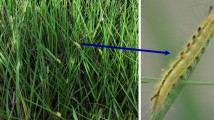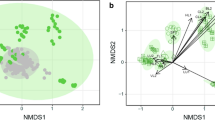Abstract
In the study of plant defense evolution, invasive plant species can be very insightful because they are often introduced without their enemies, and traits linked to defense can be released from selective pressures and evolve. Further, studying plant defense evolution in invasive species is important for biological control and use of these species. In this study, we investigated the evolution of the defensive chemicals quinolizidine alkaloids (QAs) in the invasive species gorse, Ulex europaeus. Using a common garden experiment, our goals were to characterize the role of QAs relative to specialist enemies of gorse and to investigate if QA concentration evolved in invaded regions, where gorse was introduced without these enemies. Our results showed that pod infestation rate by the seed predator Exapion ulicis and infestation by the rust pathogen Uromyces genistae-tinctoriae were negatively correlated to concentration of the QA lupanine. Quinolizidine alkaloid concentration was very variable between individuals, both within and among populations, but it was not different between native and invaded regions, suggesting that no evolution of decreased resistance occurred after gorse lost its enemies. Our study also suggests that QA concentrations are traits integrated into seed predation avoidance strategies of gorse, with plants that mass-fruit in spring but do not escape pod infestation in time being richer in QAs.



Similar content being viewed by others
References
Agrawal AA, Fishbein M (2006) Plant defense syndromes. Ecology 87:S132–S149
Agrawal AA, Kurashige NS (2003) A role for isothiocyanates in plant resistance against the specialist herbivore Pieris rapae. J Chem Ecol 29:1403–1415
Atlan A, Barat M, Légionnet AS, Parize L, Tarayre M (2010) Genetic variation in flowering phenology and avoidance of seed predation in native populations of Ulex europaeus. J Evol Biol 23(2):362–371
Barat M, Tarayre M, Atlan A (2007) Plant phenology and seed predation: interactions between gorses and weevils in Brittany (France). Entomol Exp Appl 124:167–176
Barat M, Tarayre M, Atlan A (2008) Genetic divergence and ecological specialisation of seed weevils (Exapion spp.) on gorses (Ulex spp.). Ecol Entomol 33:328–336
Benkman CW (1995) The impact of tree squirrels (Tamiasciurus) on limber pine seed dispersal adaptations. Evolution 49(4):585–592
Berenbaum MR, Zangerl AR (1998) Chemical phenotype matching between a plant and its insect herbivore. PNAS 95:13743–13748
Bermudez-Torres K, Robledo Quintos N, Barrera Necha LL, Wink M (2002) Alkaloid profile of leaves and seeds of Lupinus hintonii C.P. Smith. Z Naturforsch 57:243–247
Bermudez-Torres K, Matinez Herrera J, Figueroa Brito R, Wink M, Legal L (2009) Activity of quinolizidine alkaloids from three Mexican Lupinus against the lepidopteran crop pest Spodoptera frugiperda. BioControl 54:459–466
Blossey B, Nötzold R (1995) Evolution of increased competitive ability in invasive nonindigenous plants: a hypothesis. J Ecol 83(5):887–889
Boschin G, Annicchiarico P, Resta D, D’Agostina A, Arnoldi A (2008) Quinolizidine alkaloids in seeds of lupin genotypes of different origins. J Agric Food Chem 56:3657–3663
Bossdorf O, Auge H, Lafuma L, Rogers WE, Siemann E, Prati D (2005) Phenotypic and genetic differentiation between native and introduced plant populations. Oecology 144:1–11
Cano L, Escarré J, Vrieling K, Sans FX (2009) Palatability to a generalist herbivore, defence and growth of invasive and native Senecio species: testing the evolution of increased competitive ability hypothesis. Oecol 159:95–106
Carey D, Wink M (1994) Elevational variation of quinolizidine alkaloid contents in a lupine (Lupinus argenteus) of the rocky mountains. J Chem Ecol 20:849–857
Carmona D, Lajeunesse MJ, Johnson MTJ (2011) Plant traits that predict resistance to herbivores. Funct Ecol 25:358–367
Cipollini D, Mbagwu J, Barto K, Hillstrom C, Enright S (2005) Expression of constitutive and inducible chemical defenses in native and invasive populations of Alliaria petiolata. J Chem Ecol 31:1255–1266
Conover WJ, Iman RL (1981) Rank transformation as a bridge between parametric and nonparametric statistics. Am Stat 35:124–129
Crawley MJ (2007) The R book. Wiley, Chichester
Davies WM (1928) The bionomics of Apion ulicis Forst. (gorse weevil) with special reference to its role in the control of Ulex europaeus in New Zealand. Ann Appl Biol 15:263–286
Desprès L, David JP, Gallet C (2007) The evolutionary ecology of insect resistance to plant chemicals. Trends Ecol Evol 22:298–307
Development Core Team R (2010) R: A language and environment for statistical computing. R Foundation for Statistical Computing, Vienna
Gandon S (2002) Local adaptation and the geometry of host–parasite coevolution. Ecol Lett 5:246–256
Hill RL, Gourlay AH (2002) Host-range testing, introduction, and establishment of Cydia succedana (Lepidoptera: Tortricidae) for biological control of gorse, Ulex europaeus L., in New Zealand. Biol Control 25:173–186
Holm L, Doll J, Holm E, Pancho J, Herberger J (1997) World weeds: natural histories and distribution. Wiley, New York
Hornoy B (2011) Processus évolutifs contribuant au succès envahissant de l’ajonc d’Europe, Ulex europaeus. PhD thesis, University de Rennes 1
Hornoy B, Tarayre M, Hervé M, Gigord L, Atlan A (2011) Invasive plants and enemy release: evolution of trait means and trait correlations in Ulex europaeus. PLoS One 6(10):e26275
Janzen DH (1975) Behavior of Hymenaea courbaril when its predispersal seed predator is absent. Science 189:145–147
Janzen DH (1980) When is it coevolution? Evolution 34(3):611–612
Johnson MTJ, Agrawal AA, Maron JL, Salminen JP (2009) Heritability, covariation and natural selection on 24 traits of common evening primrose (Oenothera biennis) from a field experiment. J Evol Biol 22:1295–1307
Keane RM, Crawley MJ (2002) Exotic plant invasions and the enemy release hypothesis. Trends Ecol Evol 17(4):164–170
Liu H, Stiling P (2006) Testing the enemy release hypothesis: a review and meta-analysis. Biol Invasions 8:1535–1545
Macel M, Vrieling K, Klinkhamer PGL (2004) Variation in pyrrolizidine alkaloid patterns of Senecio jacobaea. Phytochemistry 65:865–873
Maximo P, Lourenço A, Tei A, Wink M (2006) Chemotaxonomy of Portuguese Ulex: quinolizidine alkaloids as taxonomical markers. Phytochemistry 67:1943–1949
Mitchell CE, Power AG (2003) Release of invasive plants from fungal and viral pathogens. Nature 421:625–627
Müller C, Martens N (2005) Testing predictions of the ‘evolution of increased competitive ability’ hypothesis for an invasive crucifer. Evol Ecol 19:533–550
Müller-Schärer H, Schaffner U, Steinger T (2004) Evolution in invasive plants: implications for biological control. Trends Ecol Evol 19(8):417–422
Orians CM, Ward D (2010) Evolution of plant defenses in nonindigenous environments. Annu Rev Entomol 55:439–459
Stamp N (2003) Out of the quagmire of plant defense hypotheses. Q Rev Biol 78:23–55
Stastny M, Schaffner U, Elle E (2005) Do vigour of introduced populations and escape from specialist herbivores contribute to invasiveness? J Ecol 93:27–37
Strauss SY, Rudgers JA, Lau JA, Irwin RE (2002) Direct and indirect ecological costs of resistance to herbivory. Trends Ecol Evol 17:278–285
Tarayre M, Bowman G, Schermann-Légionnet A, Barat M, Atlan A (2007) Flowering phenology of Ulex europaeus: ecological consequences of variation within and among populations. Evol Ecol 21:395–409
Thompson JN (2005) The geographic mosaic of coevolution. The University of Chicago Press, Chicago
Wang Y, Siemann E, Wheeler GS, Zhu L, Gu X, Ding J (2012) Genetic variation in anti-herbivore chemical defences in an invasive plant. J Ecol 100:894–904
Wink M (1988) Plant breeding: importance of plant secondary metabolites for protection against pathogens and herbivores. TAG 75:225–233
Wink M (1992) The role of quinolizidine alkaloids in plant insect interactions. In: Bernays EA (ed) Insect–plant interactions, vol IV. CRC, Boca Raton, pp 133–169
Wink M (1993) Quinolizidine alkaloids. In: Waterman P (ed) Methods in plant biochemistry, vol 8. Academic, London, pp 197–239
Wink M (1998) Chemical ecology of alkaloids. In: Roberts MF, Wink M (eds) Alkaloids: biochemistry, ecology and medicinal applications. Plenum, New York, pp 265–300
Wink M, Carey D (1994) Variability of quinolizidine alkaloid profiles of Lupinus argenteus (Fabaceae) from North America. Biochem Sys Ecol 22:663–669
Wink M, Roberts M (1998) Compartmentation of alkaloid synthesis, transport and storage. In: Roberts MF, Wink M (eds) Alkaloids: biochemistry, ecology and medicinal applications. Plenum, New York, pp 239–262
Wink M, Witte L (1991) Storage of quinolizidine alkaloids in Macrosiphum albifrons and Aphis genistae (Homoptera: Aphididae). Entomol Gen 15:237–254
Wink M, Hartmann T, Witte L, Rheinheimer J (1982) Interrelationship between quinolizidine alkaloid producing legumes and infesting insects: exploitation of the alkaloid-containing phloem sap of Cytisus scoparius by the broom aphid, Aphis cytisorum. Z Naturforsch 37c:1081–1086
Wink M, Botschen F, Gosmann C, Schäfer H, Waterman PG (2010) Chemotaxonomy seen from a phylogenetic perspective and evolution of secondary metabolism. Annu Plant Rev 40:364–433
Wippich C, Wink M (1985) Biological properties of alkaloids: influence of quinolizidine alkaloids and gramine on the germination and development of powdery mildew, Erysiphe graminis f. sp. hordei. Experientia 41:1477–1479
Zangerl AR, Rutledge CE (1996) Probability of attack and patterns of constitutive and induced defense: a test of optimal defense theory. Am Nat 147:599–608
Zwölfer H (1962) Ulex europaeus project; European investigations for New Zealand. Unpublished report, No. 2. Commonwealth Institute of Biological Control, Delémont, Switzerland
Acknowledgments
This work was funded by the Groupement de Recherche “Ecologie Chimique.” The authors thank Louis Parize, Astrid Backhaus, Frank Sporer, and Armelle Racapé for technical assistance and Véronique Martel and two anonymous reviewers for helpful comments on a previous version of the manuscript.
Ethical standards
The experiments described in this manuscript comply with the current laws of the countries in which they were performed.
Conflict of interest
The authors declare that they have no conflict of interest.
Author information
Authors and Affiliations
Corresponding author
Additional information
Electronic supplementary material
Below is the link to the electronic supplementary material.
ESM 1
(DOCX 40kb)
Rights and permissions
About this article
Cite this article
Hornoy, B., Atlan, A., Tarayre, M. et al. Alkaloid concentration of the invasive plant species Ulex europaeus in relation to geographic origin and herbivory. Naturwissenschaften 99, 883–892 (2012). https://doi.org/10.1007/s00114-012-0970-9
Received:
Revised:
Accepted:
Published:
Issue Date:
DOI: https://doi.org/10.1007/s00114-012-0970-9




